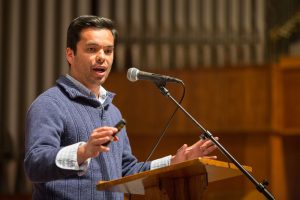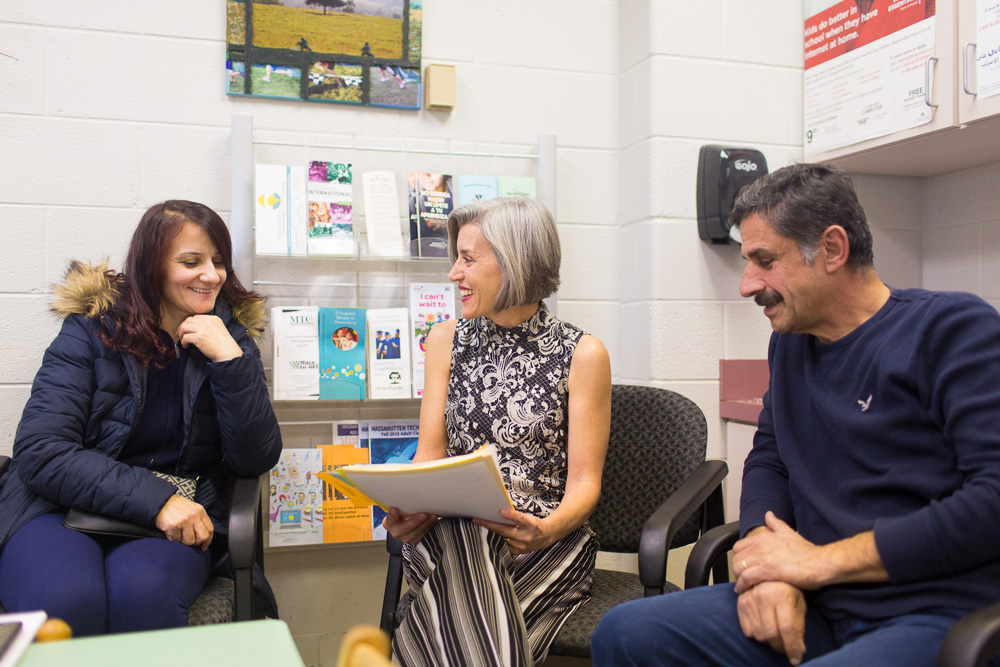In a time of rapid change and new demographics in the United States, some communities are better equipped to respond to integration of non-English-speaking immigrant and refugee populations. Because of Mennonites, and Mennonite-educated alumni of Eastern Mennonite University (EMU), Harrisonburg, Virginia, is one such community.
A recent Sojourners article, “The Multicultural Mennonites of Harrisonburg, Va.,” by Janie Tankard Carnock, program associate with New America’s Education Policy program, highlights this influence in the community, and particularly the school system, of Harrisonburg.

In a time of anti-immigrant fervor, religious distrust, and high political polarization, the peace-building Mennonites in Harrisonburg provide one robust model of how to transcend nationalism and bridge divides. Though relatively modest in size, they are showing how even a small group can affect major, positive change, shaping the hearts and minds of the local ecosystem.
“Mennonites have a unique global outlook on the inclusion and celebration of folks from other cultures,” RaMona Stahl, the Welcome Center coordinator for HCPS [Harrisonburg City Public Schools], said. Stahl, who earned a degree in social work from Eastern Mennonite University in Harrisonburg, says she did not say the Pledge of Allegiance in school as a young girl, believing her loyalty was to all peoples. “‘God and country’ — those things really shouldn’t be wed,” she said. “‘God and countries,’ yes. But not ‘country,’ singular.”
Significantly, Carnock sought through the Sojourners article to elaborate on specific findings from a report, published in October with co-researcher Amaya Garcia, titled A Critical Mass: Creating Comprehensive Services for Dual Language Learners in Harrisonburg.
“Several characteristics … imbue the community with an uncommon energy and ethos around immigrants, refugees, and dual language learners,” writes Carnock in the report. One of those “catalysts” for “progressive energy” is a large population of Mennonites, as well as the proximity of EMU, which has been educating teachers since its founding in 1917.
The Mennonite faith – ably summarized in the article by Stahl ’85, and home-school liaison Rick Castaneda ’98 – embraces diversity. This value is at the heart of teacher preparation programs offered by EMU.
“Pre-service teachers at EMU learn how to embrace diversity through equitable pedagogical practices that enhance student learning regardless of one’s racial, social, or other status in society,” says Cathy Smeltzer Erb, education department chair. “Our Anabaptist faith urges us to welcome the student as a valued member of the learning community.”

In the article, Carnock says that one of the best expressions of Mennonite influence, and of EMU’s global perspective, is the “diffusion” of these values into the work of local schools, which serve one of the highest populations of Limited English Proficient students in the state.
Approximately 112 teachers and administrators employed by Harrisonburg City Public Schools have an undergraduate or graduate degree from EMU, according to recent statistics collected from the district.
This small population of EMU-prepared educators has an outsized impact, HCPS Foreign Language Coordinator Jeremy Aldrich tells Carnock, comparing them to “yeast that makes the whole dough rise.”
The article and report highlight several initiatives for English Language Learners, among others in the district that involve EMU-educated staff and teachers:
- an expanded Welcome Center to comfortably process non-native-speaking students, led by Stahl;
- more home-school liaisons, such as Castaneda;
- and a growing Spanish-English dual immersion program in four of the district’s five elementary schools, with more than half of the teachers, including Camila Pandolfi ’12, and administrators holding an undergraduate or graduate degree from EMU.

Camila Pandolfi ’12 teaches in the Harrisonburg City Public Schools dual immersion program.
“More than ever, EMU and the broader Mennonite community are unique assets for Harrisonburg and the region,” Carnock writes. “Strongly-held beliefs about inclusion — religious or otherwise — are powerful when they translate into tangible action. In many ways, the town’s Mennonites offer a compelling example of conscious choices to humanize, rather than demonize, the other.”
Read More
The Spring 2016 Crossroads alumni magazine focuses on education, with a feature article that traces and affirms the influence of EMU-prepared teachers on the Shenandoah Valley since 1917. Read the article or access the entire issue here.
The Fall/Winter 2016 Crossroads features alumni living and working in multicultural communities of the United States. Meet people who have chosen to bridge cultures by building relationships, empowering citizens and making our country stronger and more united. Read individual articles here or page through the digital issue here.

